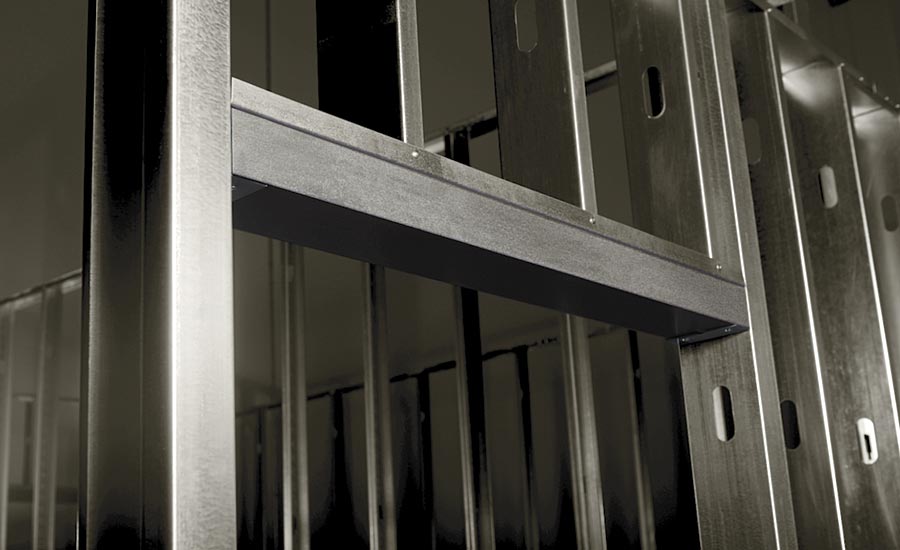Those familiar with cold-formed steel framing know just how far the industry has come over the years and its contributions to urbanization across the U.S. Its high strength-to-weight ratio—the highest of any common framing material—as well as its inherent noncombustible properties, has allowed contractors to build lighter, stronger and more resilient buildings. And, it continues to reach new heights, being used in case studies for buildings as tall as 40 stories and higher. Further, steel is a highly sustainable construction material, not just because of its strength and endurance, but because it can be recycled over and over without ever losing its quality. No other framing material can say the same.
Still, a significant part of the attraction to cold-formed steel is its reliability. Contractors can always count on it to be in the right shape and the right length. It doesn’t twist, bow or shrink. And yet, the material itself, as well as products formed of it, continue to advance. Following are several trends that are re-shaping how contractors use and interact with cold-formed steel framing.
The Entrance of Acoustic Performance Requirements
As the industry continues to refine how green building is defined, many argue it should include acoustic performance requirements. In fact, LEED v4 has STC requirements for New Construction, Data Centers, Warehouses and Distributions Centers, and Hospitality, with separate requirements for the exterior walls of schools. The merits of acoustic provisions are currently being debated and the cold-formed steel framing industry is preparing for future local and state codes that establish mandates for acoustic performance. The industry is watching and is fortunately in a good position, as many cold-formed steel assemblies already meet International Residential Code and International Building Code requirements. Still, the industry is keeping an eye on sound transmission requirements put forth by green standards as they expand to address more occupancy types, while potentially increasing the STC and IIC requirements over current IBC and IRC codes.
The BIM Solution
Going digital is already in play. It’s making a big difference for the design and building process. Take building information modeling technology; BIM makes it possible to intelligently incorporate detailed information on wall elements and design properties, such as UL assemblies based on fire-rating requirements, STC sound ratings, limiting height design and more. This is improving the collaboration among contractors, designers, and property owners. It means the real-world building process can be simulated before actual installation. As such, coordination issues among trades can be resolved before it’s too late or too costly, and productivity moves forward at a faster pace.
Increased Product Transparency
A list of steel framing innovations would be remiss to not mention green construction. Sustainable building is becoming business as usual, and as such, transparency is a progressive issue for the building sect. Manufacturers, even entire industries, are now publishing Environmental Product Declarations for their products. An EPD is a standardized, internationally recognized, comprehensive tool for providing information on a product’s environmental impact.
Verified by a third party, information in the document is based on an ISO-compliant Life Cycle Assessment. This detailed analysis considers all processes in the cradle to gate life cycle of a product, including raw material extraction and refining, energy use and efficiency during manufacture, as well as transportation methods. It is an appropriate step forward, and the steel framing niche will be better for it.
Innovative Manufacturing
Though not a new innovation per se, but a significant contribution to the cold-formed steel industry nevertheless is the use of EQ thickness studs, also known as EQ studs. These studs, which are manufactured to a thickness less than the ASTM specified 18-mil, attain the same or greater limiting heights as standard thickness members. They’re proven to have better screw shear and pullout values due to the higher strength steels used in their manufacture. Plus, they are light weight, which makes them easier for contractors to handle and install. It’s no wonder they have become the dominate choice for manufactured drywall members.
This same standard that permits EQ thickness studs, ASTM C645, has also made way for equivalent coatings. Cold-formed steel studs with EQ coatings are the new generation of high-performance, code-compliant steel framing systems. These specialized coatings permanently bond with the zinc-coated substrate to create a steel stud that exceeds requirements set forth by the International Building Code. Specifically, EQ coatings add to the corrosion resistance of the steel framing members and are proven to exceed the performance of traditional G40 coated steel.
Apps That Streamline Purchasing Decisions
Not only is product design changing, but so too is the accessibility of product information thanks to manufacturers’ adoption of mobile apps. The intent of easy-to-use apps is to provide contractors and architects quick and direct access to manufacturing information that will assist in their product and purchasing decisions. It’s a small but immeasurably useful innovation.
Cold-formed steel framing has come a long way from its use in portable houses in the 1800s. The urbanization and the broad acceptance of green construction over the last century are driving better product design, technologies and testing. It’s exciting to think what lies ahead for the industry.



















